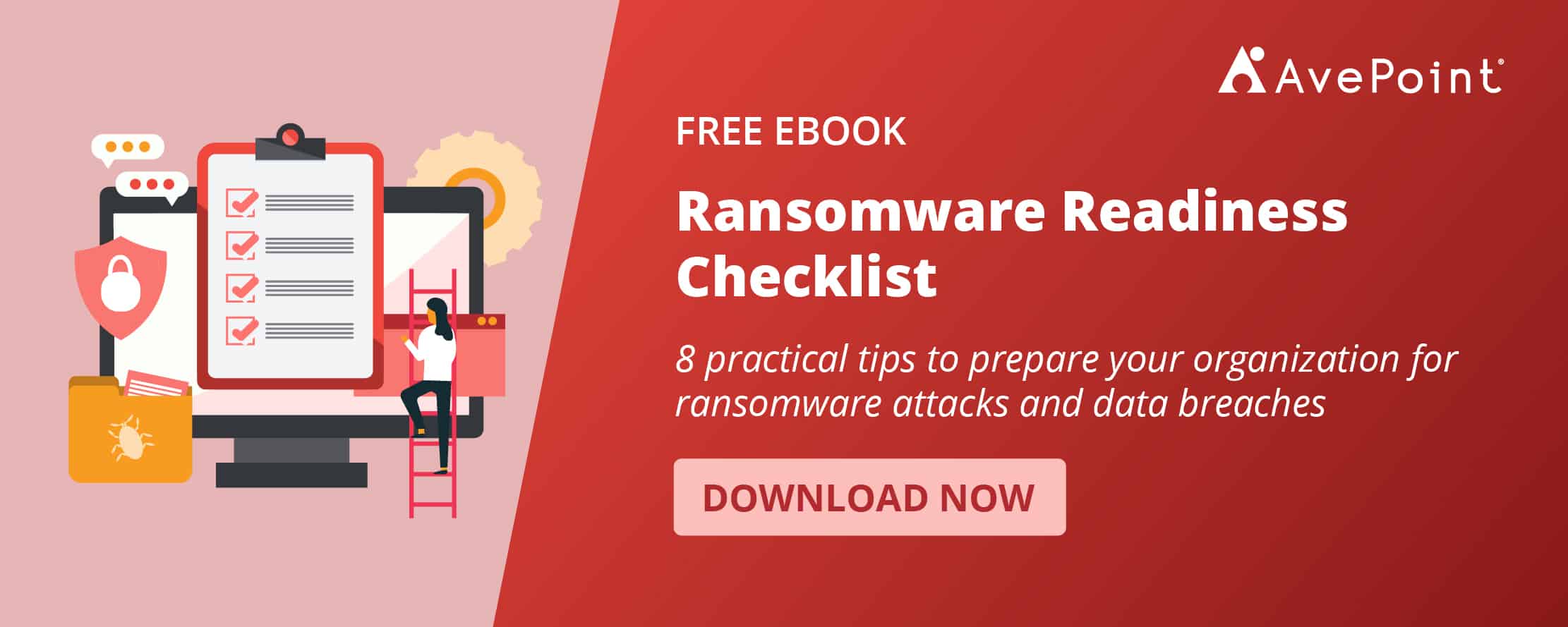The persistence of ransomware, highlighted by Forrester as a top cybersecurity threat in 2023, continues to keep cybersecurity experts on high alert.
The financial repercussions of data breaches have soared to unprecedented levels, with the global average cost now reaching $4.45 million – a record high that marks a 15.3% increase over the past three years. But the ramifications of such breaches transcend monetary losses. They encompass the potential for permanent data loss, tarnished reputation, operational disruption, and, in more dire situations, the complete downfall of businesses.
IT decision-makers are rightfully anxious, with many organizations uncertain they could recover systems and data if struck by an attack. So, how can you shore up your defenses against ransomware, and what can you do to respond when it hits? Developing a strategic approach to ransomware preparation and response is crucial.
This blog post outlines a strategic three-step approach to fortify your organization’s defenses against ransomware attacks. Additionally, it delves into valuable insights that can empower your organization to develop robust resilience, effectively reducing the potential impact of such security threats.
The 3-Step Approach to Ransomware Preparation and Response
Step 1. Prepare
Like any successful endeavor, preparation is the most important step, and it starts with developing a business continuity plan. A business continuity plan is a proactive strategy that helps organizations anticipate, respond to, and recover from disruptions effectively. This plan typically includes measures to minimize downtime, ensure data security, mitigate risks, and enable rapid recovery of critical systems and data in the event of a ransomware attack. Guidelines for prompt and timely communication with employees and stakeholders are integral components.
Central to a business continuity plan are robust backup and recovery measures. These include isolating your backups from production, securing your backup administrator credentials, and storing backup copies in immutable storage.
Implementing such measures significantly reduces the potential impact of a ransomware attack and, like a reliable insurance policy, can save you a great deal of trouble and money.
However, organizations must approach this seriously and should be ready to make a lot of difficult decisions, like whether to entertain ransom demands. Keep in mind the odds are not in favor of payment as a method of recovery. Despite the temptation, statistics show that paying ransoms doesn’t guarantee full data recovery. So, a thoughtful, proactive stance against ransomware is crucial.
Your backup solution should allow you to bring your data and systems back to how they were exactly before the attack happened. A comprehensive backup and restore solution like AvePoint Cloud Backup offers coverage for all your critical workloads, including Microsoft 365, Salesforce, Google Workspace, Azure, Power Platform, and Dynamics 365, with point-in-time recovery, enabling precise time-based data restoration. That means you can restore anything important to your business – from Teams chats to Salesforce metadata – to exactly how you remember it before the attack.
Cloud Backup not only helps you protect and restore critical information, but its machine learning-based monitoring can alert you to suspicious activity, which could indicate a ransomware attack or other nefarious activity before it spreads further. Upon detecting potential threats, it alerts IT administrators or ticketing systems via email, who can then take further action, like consult the Microsoft 365 Unusual Activities Analysis Report or activate their response plan if an attack is confirmed. It’s important to identify a clean backup that’s free of ransomware.
This capability can also speed up an organization’s recovery times by highlighting recovery points just before the unusual activity, which most likely contains clean Microsoft 365 data.
Not sure if you’re prepared for ransomware? Check out AvePoint’s Ransomware Readiness Checklist to see if you have all your bases covered.
Step 2. Stay Cool
When a ransomware incident strikes, keeping your cool is crucial. Panic can lead to hastily made choices that may worsen the situation or compromise your organization’s security further. By staying calm, you can effectively lead your team through the incident response process and mitigate the damage caused by the attack.
The first thing you must do is establish clear communication. All your key stakeholders, including executive leadership, IT, incident response, public relations and communications, human resources, and legal, should be on the same page. Communicate clearly and promptly with stakeholders to manage expectations and reduce panic.
Now is also the time for your business continuity plan to shine. If you prepare properly, you can easily execute the pre-established processes you set forth in your plan. This may include isolating affected systems, assessing the scope of the attack, notifying government regulatory agencies, and contacting law enforcement if necessary. Your tasks will be prioritized based on your organization’s specific needs and regulatory requirements.
Equally as important is minimizing downtime for the rest of the organization. And if you have a good backup and recovery solution that regularly backs up your entire digital workplace, this should be a breeze. Simply notify IT to commence the backup and recovery plan, which would allow you to recover your systems and get your organization back to work without paying a ransom.
This can all seem very overwhelming, especially when faced with the urgency and uncertainty of a ransomware attack. Remind yourself that you are not alone; last year, 70% of organizations encountered similar challenges, and the majority steered through these difficult situations successfully.
The most effective way to stay calm is through consistent practice and regular review of your response plan. While it might seem tedious, ensuring that even the simplest elements, such as call trees, remain up-to-date is crucial. Organizations change all the time, and knowing who to call or having a backup contact in case they are unavailable could mean the difference between the minutes and hours needed for a response.
Step 3. Recover
The question isn’t if a disaster will strike but when. In that critical moment, the robustness of your business continuity strategy will be tested. Will you be able to safeguard your data’s integrity and swiftly restore operational functionality?
The essence of a sound business continuity plan lies not just in rapid response but also in its foresight to mitigate risks proactively, ensuring minimal downtime and securing your enterprise’s continuity against all odds.
That’s why the kind of recovery you need is one that restores your entire digital environment to the way it was before the attack happened. AvePoint Cloud Backup can assist in identifying when the ransomware attack occurred through its ransomware detection capability. It can also help determine the appropriate recovery point with point-in-time recovery, enabling precise time-based data restoration. Moreover, it ensures a thorough and detailed recovery of Microsoft 365 content, including metadata.
AvePoint Cloud Backup’s leading-edge app-aware data recovery and granular recovery features are also key to restoring your entire digital environment to its pre-attack state.
- Isolated Backups: The cybercriminals know you’re relying on your backups. With AvePoint, your backups are completely isolated from your production systems ensuring that a compromise of your internal network doesn’t compromise your backups.
- App-Aware Recovery: This feature ensures comprehensive restoration of SaaS applications, not just your files. It reinstates the entire ecosystem — settings, configurations, and inter-data relationships — back to its pre-disruption state, enabling seamless functionality post-recovery.
- Granular Recovery: This enables precise, on-demand restoration, from individual documents to specific versions. It facilitates security rollbacks and content relocation, including exports beyond the original platform — like emails to PSTs or files to shared drives — offering unparalleled industry specificity.
- Express Recovery (In Preview): This feature enables you to recover faster than ever before. AvePoint Cloud Backup Express, now in Private Preview, allows organizations to restore their SaaS data 20X faster than traditional cloud backup.
Accomplishing these steps helps you gain peace of mind, knowing you have the right game plan to quickly resume business operations with minimal downtime and disruption.
Bolster Your Defenses Against Ransomware
As threat actors employ more advanced techniques, bolstering your organization’s defenses becomes increasingly critical. The recent $22 million ransomware attack on a US-based healthcare company is a stark reminder of the potential consequences. However, with proper preparation and a strong response strategy, your organization can significantly reduce the negative impact caused by such incidents.
To learn more about how you can protect your organization against ransomware attacks, watch our on-demand webinar 5 Critical Tips to Protect Against Ransomware Attacks.



